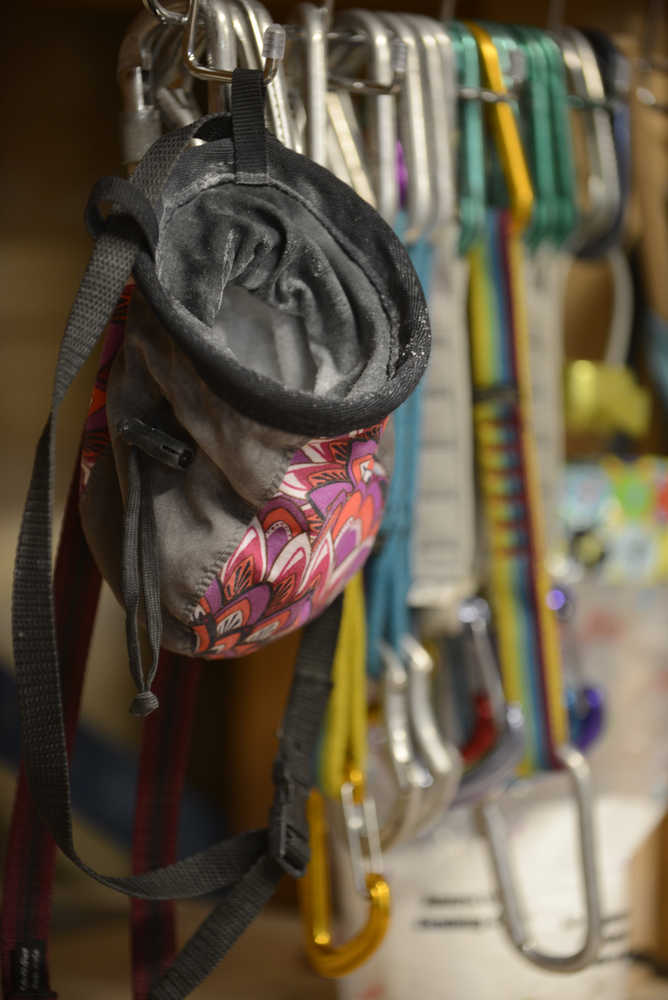For one Soldotna couple, climbing is more than just a business.
“It’s like an art form,” said Nic Larson, who along with his wife Natalie opened Redoubt Rock Climbing at their Soldotna home more than a year ago.
While the gym continues to grow, the couple began by teaching the sport of bouldering — climbing at relatively low heights without a harness or rope — to students between the ages of 6-12. Soon after opening, adults started inquiring about lessons, so the Larsons began having open gyms and classes for all ages and levels. They have even opened the venue for birthday parties.
During a normal lesson, students attempt to climb different routes called ‘problems’ depending on their skill level and needs. The Larsons try to tailor the routes to a student’s specific requirements, and they constantly change the routes and move the grips to keep climbers challenged.
“The (problems) are kind of like a math equation to figure out,” said Nic Larson.
According to the Larsons, bouldering is 50 percent problem solving and 50 percent physical. Natalie Larson said that each climber has a unique style, and it is exciting to see climbers solve the same problems in different ways.
“It’s really cool to see, because it is an individual sport and the nice thing about it is that it becomes your own style and your own moves,” she said.
While bouldering only requires chalk, pads and climbing shoes, the skills acquired can be applied to other climbing styles, such as sport climbing or traditional climbing.
“Even if you’re an alpine climber or an ice-climber, you still boulder – using those muscles,” said Natalie Larson.
Self-described as ‘laid back,’ the Larsons have been flexible when it comes to teaching other forms of climbing. Whether it’s mountaineering or ice climbing, the Larsons said they are willing to help people explore different styles.
“We know all genres,” said Natalie Larson. “This is our life.”
The couple recently started teaching about equipment terminology and safety techniques. Many topics are covered in the educational classes, including how to read ice, be aware of avalanches and understand rope. The Larsons said this information is helpful if students want to attempt other climbing styles in the future.
“We like to polish them up so [knowing the equipment] is second nature,” said Nic Larson. “If you use all of your gear properly, the risks are very little.”
Students receive instructions on the ground in the rock gym, and then when the students are ready, they can go out with the instructors to practice on real boulders and crags. When students go outdoors to sport climb or traditional climb, they can be harnessed to ensure safety.
By learning about the equipment and other forms of climbing, Natalie Larson said students acquire the tools necessary to be successful climbers later on in life.
“When they grow older – because we’ve kind of planted the seed of climbing at this point – if they go climbing later on they’ll know the [gear],” she said. “Safety-wise, they’ll be good.”
For the Larsons, climbing is much more than a leisure pursuit. The two have completely immersed themselves in the culture. They even study climbing routes worldwide.
“We’ve never been to Nepal, but we could tell you about routes and where to go there,” said Nic Larson. “We’ve really immersed ourselves in the lifestyle and it has helped us be able to teach.”
Closer to home, the Larsons said that climbing in Alaska poses some challenges. Some rock, like that found near Captain Cook State Park is good for climbing, while many other places in the state have weak, crumbly rock that is less suitable.
Despite some challenges, the Larsons love all the opportunity to get out and climb.
“I get stoked,” said Natalie Larson. “It’s an adventure.”
For more information about Redoubt Rock Climbing, go to:
http://redoubtrockclimbing.blogspot.com
Reach Ian Foley at Ian.foley@peninsulaclarion.com

